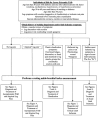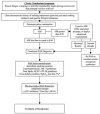Peripheral artery disease and chronic kidney disease: clinical synergy to improve outcomes
- PMID: 25443571
- PMCID: PMC4254470
- DOI: 10.1053/j.ackd.2014.07.005
Peripheral artery disease and chronic kidney disease: clinical synergy to improve outcomes
Abstract
Persons with CKD are at a higher risk of developing peripheral artery disease (PAD) and its adverse health outcomes than individuals in the general population who have normal renal function. Classic atherosclerosis risk factors (eg, age, smoking, diabetes, hypertension, and hyperlipidemia) are common in patients with CKD, but CKD also imposes additional unique risk factors that promote arterial disease (eg, chronic inflammation, hypoalbuminemia, and a procalcific state). Current nephrology clinical practice is adversely affected by PAD diagnostic challenges, the complexities of managing 2 serious comorbid diseases, delayed vascular specialist referral, and slow PAD treatment initiation in patients with CKD. Persons with CKD are less likely to be provided recommended "optimal" PAD care. The knowledge that both limb and mortality outcomes are significantly worse in patients with CKD, especially those on dialysis, is not just a biologic fact but can serve as a care delivery call to action. Nephrologists can facilitate positive change. This article proposes that patients with PAD and CKD be strategically comanaged by care teams that encompass the skills to create and use evidence-based care pathways. This proposed collaborative multidisciplinary approach will include vascular medicine specialists, nephrologists, wound specialists, and mid-level providers. Just as clinical care quality metrics have served as the base for ESRD and acute MI quality improvement, it is time that such quality outcomes metrics be initiated for the large PAD-CKD population. This new system will identify and resolve key gaps in the current care model so that clinical outcomes improve within a cost-effective care frame for this vulnerable population.
Keywords: Clinical outcomes; Collaborative care; Kidney disease; Multidisciplinary teams; Peripheral artery disease.
Copyright © 2014 National Kidney Foundation, Inc. Published by Elsevier Inc. All rights reserved.
Conflict of interest statement
Figures
References
-
- Foley RN, Murray AM, Li S, et al. Chronic kidney disease and the risk for cardiovascular disease, renal replacement, and death in the United States Medicare population, 1998 to 1999. Journal of the American Society of Nephrology : JASN. 2005 Feb;16(2):489–495. - PubMed
-
- Keith DS, Nichols GA, Gullion CM, Brown JB, Smith DH. Longitudinal follow-up and outcomes among a population with chronic kidney disease in a large managed care organization. Archives of internal medicine. 2004 Mar 22;164(6):659–663. - PubMed
-
- Sarnak MJ, Levey AS, Schoolwerth AC, et al. Kidney disease as a risk factor for development of cardiovascular disease: a statement from the American Heart Association Councils on Kidney in Cardiovascular Disease, High Blood Pressure Research, Clinical Cardiology, and Epidemiology and Prevention. Hypertension. 2003 Nov;42(5):1050–1065. - PubMed
-
- O'Hare AM, Glidden DV, Fox CS, Hsu CY. High prevalence of peripheral arterial disease in persons with renal insufficiency: results from the National Health and Nutrition Examination Survey 1999-2000. Circulation. 2004 Jan 27;109(3):320–323. - PubMed
Publication types
MeSH terms
Grants and funding
LinkOut - more resources
Full Text Sources
Other Literature Sources
Medical
Molecular Biology Databases
Miscellaneous




